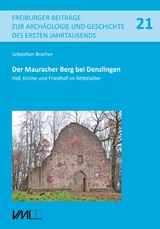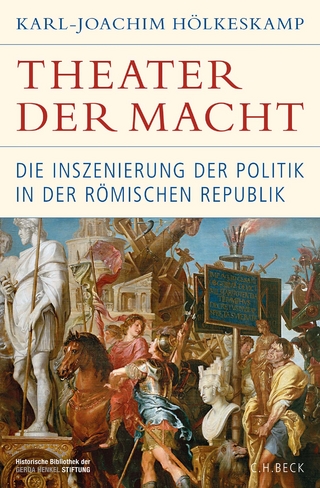Der Mauracher Berg bei Denzlingen
Hof, Kirche und Friedhof im Mittelalter
Seiten
| Ausstattung: Sonstiges Produkt
2024
|
1., Aufl.
VML Vlg Marie Leidorf (Verlag)
978-3-89646-781-2 (ISBN)
VML Vlg Marie Leidorf (Verlag)
978-3-89646-781-2 (ISBN)
Around A.D. 950 King Otto I transferred the Mauracher Berg in the Rhine valley to the Bishop of Constance. At the foot of the hill lies the Mauracher Hof farm with a Villa rustica of the 2nd/3rd century. A.D. The church, first mentioned in A.D. 1155, served as a parish church and cemetery for the mining settlements of the Glotter Valley until ca. A.D. 1450. Ground radar and excavations from 2011-16 revealed a basilical church with a round apse and tiled roof [11th/12th century, Phase I] which was given a square choir in the 13th century [Ph. IIa] and a choir steeple and retaining walls [Ph. IIb] in the Late Middle Ages. This was replaced in 1497 by a pilgrim’s church to St Severin [Ph. III], which was closed in 1556 due to reformation. 68 graves with hardly any grave goods from the 11th-15th century surrounded the church. Three graves of the 8th-10th century belonged to a comital farmstead of the Early Middle Ages with post buildings, sunken-featured buildings and possibly a ditched defence. Few graves of the 16th-17th century followed after the church had been closed. Anthropology testifies to the normal living conditions of the population with many dental diseases and occasional food shortages. Small finds included a funeral crown, 8th-17th c.entury pottery, coins, military finds, household and craft utensils as well as components of dress, jewellery and games. Der Mauracher Berg in der Rheinebene wurde um 950 von König Otto I. dem Konstanzer Bischof übertragen. Am Bergfuß liegt der Mauracher Hof mit einer Villa rustica des 2./3. Jh. Die 1155 erstgenannte Kirche diente bis um 1450 als Pfarrkirche und Friedhof für die Bergbausiedlungen des Glottertals. Georadarmessungen und Ausgrabungen von 2011-16 ergaben, daß ein Saalbau mit Rundapsis und Ziegeldach [11./12. Jh., Bau I] einen eckigen Chorabschluss [13. Jh., Bau IIa] und im Spätmittelalter einen Chorturm und Stützmauern [Bau IIb] erhielt. Dieser wurde 1497 durch eine spätgotische Wallfahrtskirche des Hl. Severin ersetzt [Bau III], die 1556 mit der Reformation geschlossen wurde. 68 weitgehend beigabenlose Gräber des 11.-15. Jh. umgaben die Kirche. Drei Gräber des 8.-10. Jh. gehörten zu einem gräflichen Gehöft des Frühmittelalters mit Pfostenbauten, Grubenhäusern und evtl. Spitzgrabenwehr. Wenige Gräber des 16.-17. Jh. folgten nach der Kirchenschließung. Die Anthropologie bezeugt normale Lebensbedingungen der Bevölkerung mit vielen Zahnerkrankungen und gelegentlichem Nahrungsmangel. An Kleinfunden sind eine Totenkrone, Keramik des 8.-17. Jh., Münzen, Militaria, Haushaltsgerät und Handwerksgerät, Kleidungsbestandteile, Schmuckbestandteile und Spielbestandteile zu erwähnen.
Around A.D. 950 King Otto I transferred the Mauracher Berg in the Rhine valley to the Bishop of Constance. At the foot of the hill lies the Mauracher Hof farm with a Villa rustica of the 2nd/3rd century. A.D. The church, first mentioned in A.D. 1155, served as a parish church and cemetery for the mining settlements of the Glotter Valley until ca. A.D. 1450. Ground radar and excavations from 2011-16 revealed a basilical church with a round apse and tiled roof [11th/12th century, Phase I] which was given a square choir in the 13th century [Ph. IIa] and a choir steeple and retaining walls [Ph. IIb] in the Late Middle Ages. This was replaced in 1497 by a pilgrim’s church to St Severin [Ph. III], which was closed in 1556 due to reformation. 68 graves with hardly any grave goods from the 11th-15th century surrounded the church. Three graves of the 8th-10th century belonged to a comital farmstead of the Early Middle Ages with post buildings, sunken-featured buildings and possibly a ditched defence. Few graves of the 16th-17th century followed after the church had been closed. Anthropology testifies to the normal living conditions of the population with many dental diseases and occasional food shortages. Small finds included a funeral crown, 8th-17th c.entury pottery, coins, military finds, household and craft utensils as well as components of dress, jewellery and games.
Around A.D. 950 King Otto I transferred the Mauracher Berg in the Rhine valley to the Bishop of Constance. At the foot of the hill lies the Mauracher Hof farm with a Villa rustica of the 2nd/3rd century. A.D. The church, first mentioned in A.D. 1155, served as a parish church and cemetery for the mining settlements of the Glotter Valley until ca. A.D. 1450. Ground radar and excavations from 2011-16 revealed a basilical church with a round apse and tiled roof [11th/12th century, Phase I] which was given a square choir in the 13th century [Ph. IIa] and a choir steeple and retaining walls [Ph. IIb] in the Late Middle Ages. This was replaced in 1497 by a pilgrim’s church to St Severin [Ph. III], which was closed in 1556 due to reformation. 68 graves with hardly any grave goods from the 11th-15th century surrounded the church. Three graves of the 8th-10th century belonged to a comital farmstead of the Early Middle Ages with post buildings, sunken-featured buildings and possibly a ditched defence. Few graves of the 16th-17th century followed after the church had been closed. Anthropology testifies to the normal living conditions of the population with many dental diseases and occasional food shortages. Small finds included a funeral crown, 8th-17th c.entury pottery, coins, military finds, household and craft utensils as well as components of dress, jewellery and games.
| Erscheinungsdatum | 09.09.2024 |
|---|---|
| Reihe/Serie | Freiburger Beiträge zur Archäologie und Geschichte des ersten Jahrtausends ; 21 |
| Co-Autor | Marianne Kupetz, Valerie Schonenberg |
| Verlagsort | Rahden/Westf. |
| Sprache | deutsch |
| Maße | 210 x 297 mm |
| Gewicht | 1570 g |
| Einbandart | gebunden |
| Themenwelt | Geschichte ► Allgemeine Geschichte ► Altertum / Antike |
| Schlagworte | Gräberfeld • Höhensiedlung • Kirche • Siedlungsarchäologie • Villa Rustica |
| ISBN-10 | 3-89646-781-6 / 3896467816 |
| ISBN-13 | 978-3-89646-781-2 / 9783896467812 |
| Zustand | Neuware |
| Haben Sie eine Frage zum Produkt? |
Mehr entdecken
aus dem Bereich
aus dem Bereich
die Inszenierung der Politik in der römischen Republik
Buch | Hardcover (2023)
C.H.Beck (Verlag)
CHF 67,20
Buch | Hardcover (2024)
Klett-Cotta (Verlag)
CHF 69,95




